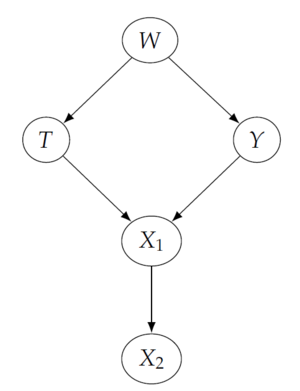“D-分离”的版本间的差异
Chancychen(讨论 | 贡献) |
Chancychen(讨论 | 贡献) |
||
| 第11行: | 第11行: | ||
''<math> \mathcal{I}(\mathcal{G}) = \left\{ (\mathbf{X} \perp \!\!\! \perp \mathbf{Y} \mid \mathbf{Z}) : d-sep_{\mathcal{G}(\mathbf{X}l\mathbf{Y} \mid \mathbf{Z}) } \right\} </math>'' | ''<math> \mathcal{I}(\mathcal{G}) = \left\{ (\mathbf{X} \perp \!\!\! \perp \mathbf{Y} \mid \mathbf{Z}) : d-sep_{\mathcal{G}(\mathbf{X}l\mathbf{Y} \mid \mathbf{Z}) } \right\} </math>'' | ||
| − | == d- | + | == d-分离的解释 == |
=== 激活路径的定义 === | === 激活路径的定义 === | ||
| 第22行: | 第22行: | ||
由d-分离的定义可知,<math> d-sep_{\mathcal{G}(\mathbf{X}l\mathbf{Y} \mid \mathbf{Z}) } </math>实际上指的就是将所有<math> \mathbf{X} </math>和<math> \mathbf{Y} </math>间的激活路径以及相应激活结点集找出,只要保证<math> \mathbf{Z} </math>中没有激活节点集中的结点,且不含<math> \mathbf{X} </math>与<math> \mathbf{Y} </math>中结点即可做到d-分离。 | 由d-分离的定义可知,<math> d-sep_{\mathcal{G}(\mathbf{X}l\mathbf{Y} \mid \mathbf{Z}) } </math>实际上指的就是将所有<math> \mathbf{X} </math>和<math> \mathbf{Y} </math>间的激活路径以及相应激活结点集找出,只要保证<math> \mathbf{Z} </math>中没有激活节点集中的结点,且不含<math> \mathbf{X} </math>与<math> \mathbf{Y} </math>中结点即可做到d-分离。 | ||
| − | === 根据阻断路径的解释 === | + | === 根据阻断路径的解释<ref>Pearl J, Glymour M, Jewell N P. Causal inference in statistics: A primer[M]. John Wiley & Sons, 2016.</ref> === |
类似激活路径的定义,我们还可以定义阻断路径: | 类似激活路径的定义,我们还可以定义阻断路径: | ||
| 第32行: | 第32行: | ||
有了阻断路径的定义,我们可以重新定义d-分离为: | 有了阻断路径的定义,我们可以重新定义d-分离为: | ||
| − | ''如果<math> \mathbf{Z} </math>阻断了<math> \mathbf{X} </math>和<math> \mathbf{Y} </math>之间的每一条路径,则称<math> \mathbf{X} </math>和<math> \mathbf{Y} </math>是给定<math>\mathbf{Z} </math>下d-分离的,<math> \mathbf{X} </math>和<math> \mathbf{Y} </math>在给定<math>\mathbf{Z} </math>下条件独立。''<references>''<math>\mathbf{Z} </math>''</references> | + | ''如果<math> \mathbf{Z} </math>阻断了<math> \mathbf{X} </math>和<math> \mathbf{Y} </math>之间的每一条路径,则称<math> \mathbf{X} </math>和<math> \mathbf{Y} </math>是给定<math>\mathbf{Z} </math>下d-分离的,<math> \mathbf{X} </math>和<math> \mathbf{Y} </math>在给定<math>\mathbf{Z} </math>下条件独立。'' |
| + | |||
| + | === d-分离实例 === | ||
| + | [[文件:D-sep ex1.png|缩略图|实例]] | ||
| + | 在此图中,T和Y是给定W下d-分离的。但当Z取空集、{W,X1}、{W,X2}等情况下,T和Y不满足d-分离条件。 | ||
| + | |||
| + | == d-分离算法 == | ||
| + | |||
| + | == d-分离在因果推断中的应用 == | ||
| + | <references>''<math>\mathbf{Z} </math>''</references> | ||
2021年7月21日 (三) 09:19的版本
d-分离是一套决定准则:对于给定的因果图,决定在给定变量集合Z的情况下,变量集合X和变量集合Y是否独立[1]。
d-分离的基本思想
它的基本想法是将统计意义上的“独立性”与图论中的“分离性”(“非连通性”)联系起来。这个基本想法首先需要我们去定义在给定的有向图中给定结点集Z取值下的“激活路径”。d-分离中的“d”实际上指示了我们讨论的目标为有向图。
d-分离的定义
令[math]\displaystyle{ \mathbf{X} }[/math],[math]\displaystyle{ \mathbf{Y} }[/math],是图[math]\displaystyle{ \mathcal{G} }[/math]中的三个结点集合。如果在给定Z的条件下,任意[math]\displaystyle{ X \in \mathbf{X} }[/math]与[math]\displaystyle{ Y \in \mathbf{Y} }[/math]两个结点间没有激活路径,则称[math]\displaystyle{ \mathbf{X} }[/math]和[math]\displaystyle{ \mathbf{Y} }[/math]是给定[math]\displaystyle{ \mathbf{Z} }[/math]下d-分离的,记作[math]\displaystyle{ d-sep_{\mathcal{G}(\mathbf{X}l\mathbf{Y} \mid \mathbf{Z}) } }[/math]。
将结点间的一系列独立性关系记作[math]\displaystyle{ \mathcal{I}(\mathcal{G}) }[/math],从而可将独立性和d-分离联系起来:
[math]\displaystyle{ \mathcal{I}(\mathcal{G}) = \left\{ (\mathbf{X} \perp \!\!\! \perp \mathbf{Y} \mid \mathbf{Z}) : d-sep_{\mathcal{G}(\mathbf{X}l\mathbf{Y} \mid \mathbf{Z}) } \right\} }[/math]
d-分离的解释
激活路径的定义
假设[math]\displaystyle{ \mathcal{G} }[/math]是一个贝叶斯网络,[math]\displaystyle{ \mathbf{Z} }[/math]是给定的已观测变量集,我们称一条路径[math]\displaystyle{ \mathbf{X}_1 \leftrightarrow \cdots \leftrightarrow \mathbf{X}_n }[/math]是给定[math]\displaystyle{ \mathbf{Z} }[/math]下激活的,当且仅当:
- 当路径中出现如此形式的V-结构:[math]\displaystyle{ \mathbf{X}_{i-1} \rightarrow \mathbf{X}_{i} \leftarrow \mathbf{X}_{i+1} }[/math]时,[math]\displaystyle{ \mathbf{X}_{i} }[/math]或它的某个子孙结点在[math]\displaystyle{ \mathbf{Z} }[/math]中。
- 其它任何路径中的结点都不在[math]\displaystyle{ \mathbf{Z} }[/math]中。
根据激活路径的解释
由d-分离的定义可知,[math]\displaystyle{ d-sep_{\mathcal{G}(\mathbf{X}l\mathbf{Y} \mid \mathbf{Z}) } }[/math]实际上指的就是将所有[math]\displaystyle{ \mathbf{X} }[/math]和[math]\displaystyle{ \mathbf{Y} }[/math]间的激活路径以及相应激活结点集找出,只要保证[math]\displaystyle{ \mathbf{Z} }[/math]中没有激活节点集中的结点,且不含[math]\displaystyle{ \mathbf{X} }[/math]与[math]\displaystyle{ \mathbf{Y} }[/math]中结点即可做到d-分离。
根据阻断路径的解释[2]
类似激活路径的定义,我们还可以定义阻断路径:
一条路径被一组结点[math]\displaystyle{ \mathbf{Z} }[/math]阻断,当且仅当:
- 路径中包含链结构或分叉结构,则中间结点包含在[math]\displaystyle{ \mathbf{Z} }[/math]中。
- 路径中包含对撞结构,则对撞结点及其子孙结点都不在[math]\displaystyle{ \mathbf{Z} }[/math]中。
有了阻断路径的定义,我们可以重新定义d-分离为:
如果[math]\displaystyle{ \mathbf{Z} }[/math]阻断了[math]\displaystyle{ \mathbf{X} }[/math]和[math]\displaystyle{ \mathbf{Y} }[/math]之间的每一条路径,则称[math]\displaystyle{ \mathbf{X} }[/math]和[math]\displaystyle{ \mathbf{Y} }[/math]是给定[math]\displaystyle{ \mathbf{Z} }[/math]下d-分离的,[math]\displaystyle{ \mathbf{X} }[/math]和[math]\displaystyle{ \mathbf{Y} }[/math]在给定[math]\displaystyle{ \mathbf{Z} }[/math]下条件独立。
d-分离实例
在此图中,T和Y是给定W下d-分离的。但当Z取空集、{W,X1}、{W,X2}等情况下,T和Y不满足d-分离条件。
